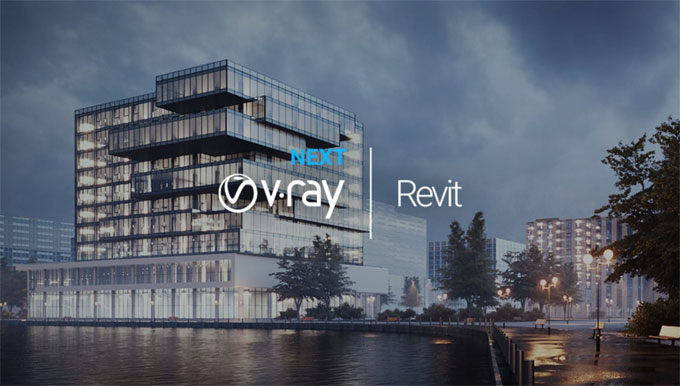V-Ray Next by Chaos Group for Revit
Tweet
The Chaos Group released V-Ray for the Revit software. It has the capability of high quality of rendering out of Autodesk's software of building design. It is very similar to V-Ray for SketchUp and Rhino.
By using V-Ray architects can transform the complex problem for producing renders which is photorealistic into very easy solution. V-Ray is different from Autodesk's high quality Arnold renderer. It is very much required Revit files to be linked and rendered in a different host package. The name of it is 3ds Max.
This V-Ray can work within the topic of Revit so that it can define rendering process. Chaos Group took the advantages of artificial Intelligence so that it can increase the speed of rendering and improves the renders.
Features of V-Ray for Revit
1. V-Ray Next is very fast, smart and more efficient than any other software.
2. V-Ray also has asset editor. So, users now can edit, create, save and manage V-Ray materials in one particular place.
3. Revit users are able to analyze lightning from daylight by evaluating real world lux values.
4. V-Ray also improves the performance and intelligence.
5. It also promotes CPU and GPU speed boots.
6. Physical camera of V-Ray can set the correct exposure of camera and maintain the white balance automatically.
7. V-Ray also has realtime AI denoiser. It reduces noise of images to help the user for obtaining a sense of lightning frequently.
V-ray provides efficiency so that users can easily run the rendering process. V-ray actually wants to simplify the experience of users. V-Ray has an advanced toolbar. It can support Revit decals so it can easily make painting of render signs, screens and many more.
Now Revit users are able to save their V-Ray setting within Revit project. Also, a new workflow also allows the users to save directly to a Revit project from V-Ray frame buffer.
Photorealistic rendering is very much costly and complex so mediocre architects can't complete their regular design workflow. This V-Ray technology provides users to take photographs which is professional looking. There is no doubt that the combination of faster process and artificial intelligence can improve synthetic rendering too. V-Ray next to Revit provides the Revit users a better experience in architecture.
Cost and availability of V-Ray next for Revit
V-Ray next to Revit is available for worldwide users. $750 users can get the full workstation license. Users also can get the upgraded version at $395.
V-Ray next also can be rented. And the rental price is $350 per year and $60 per month. There is a free 30-day trial option available for users so they can understand the software very easily for further usage.
Benefits of V-Ray next for Revit
Perfection
V-Ray can analyze designs made by Revit users. It analyzes this according to the lightning and reflection and refraction of the materials.
Revit integration seamlessly
It can keep all sort of Revit project without altering the BIM database. Revit can complete all the workflow. So, there is no import and export.
Interoperability
The V-Ray work can be done by using other 3D based tools like 3ds Max, Rhino or SketchUp for assets which are render ready and can be reused.
Custom entourage
V-Ray can custom 3D based entourage in Revit. It has no need to pollute BIM database or to impact performance of Revit.
Good quality
V-Ray next for Revit can make easily traditional monochromatic studies without overriding the convenient material.
Power
V-Ray can increase the speed of workflow with multiple processors. It also can harness networked machines with swarm. It also can use Chaos cloud in order to require.
Key features of V-Ray next
Rendering:
1. CPU and GPU and hybrid rendering
2. Interactive rendering
3. Denoiser
4. Render channels
5. Scene intelligence
6. Chaos cloud
7. V-Ray swarm
8. Setting management.
User interface of V-Ray:
1. Integration seamlessly
2. Asset editor
3. Appearance manager
4. Frame buffer
Lightning:
1. Lightning perfectly
2. Adaptive lights
3. Dome light
4. Analyze the lightning
Camera:
1. Real world cameras
2. White balance and auto exposure
3. Effect of lens
4. Virtual reality
5. DOF and vignetting
Texture and material:
1. The physical material
2. Material library
3. Support of native material
4. Decal
5. Texture maps
6. Overriding material
In this article we discussed about V-Ray next for Revit, features of V-Ray, the rendering process, cost and availability, benefits like power, good quality, custom entourage, interoperability, seamless integration.
If readers like this article of V-Ray for reedit then please share your opinion with us below the article. We are very eager to know your opinion about this article.

Image Courtesy: chaosgroup.com
Gallery
Feel free to contact us for BIM requirements. One of our representative will respond you within 24 Hours. Send us your projects requirement today and grow your project.
Explore More !







